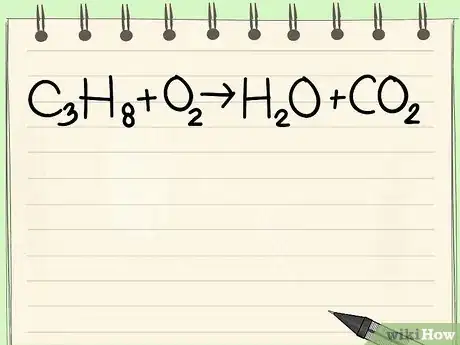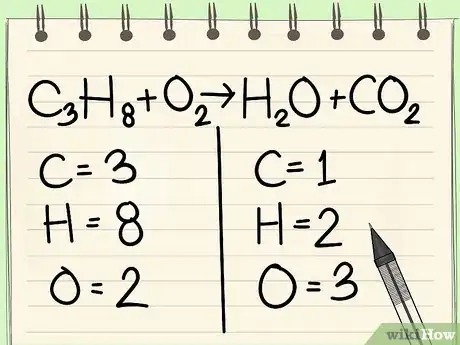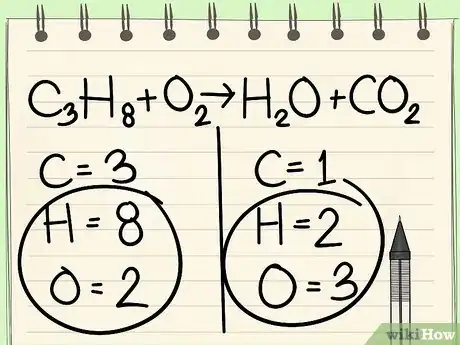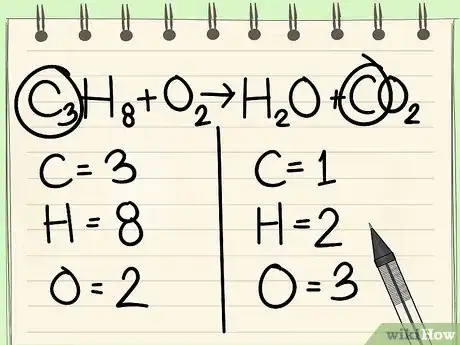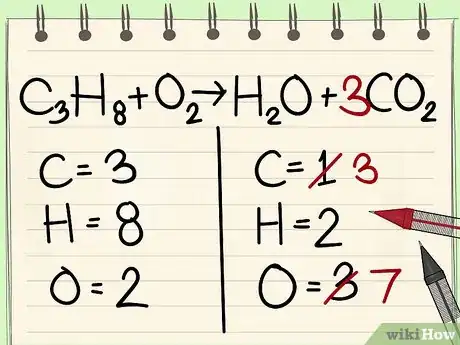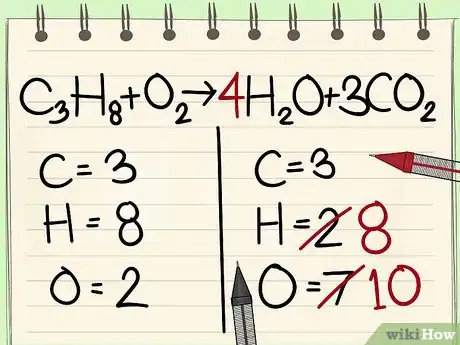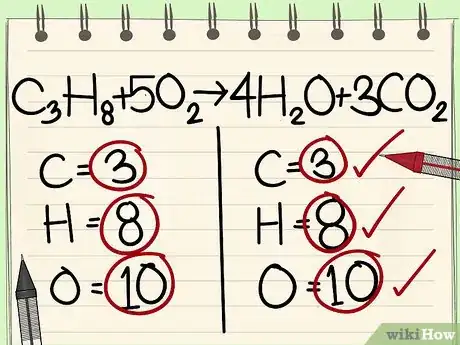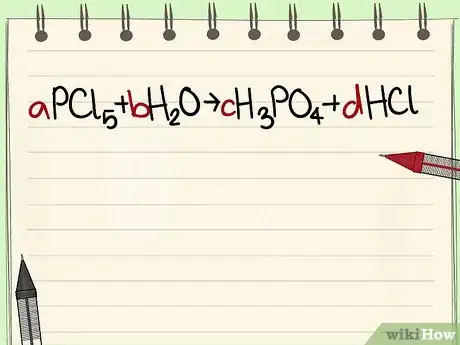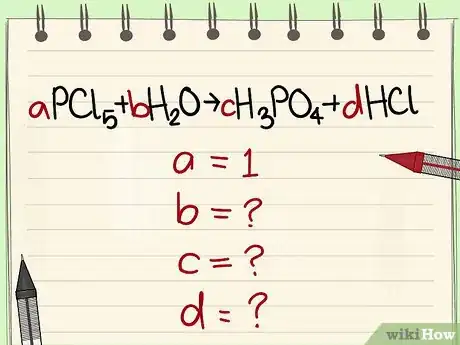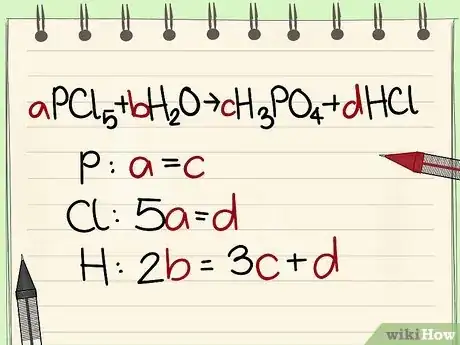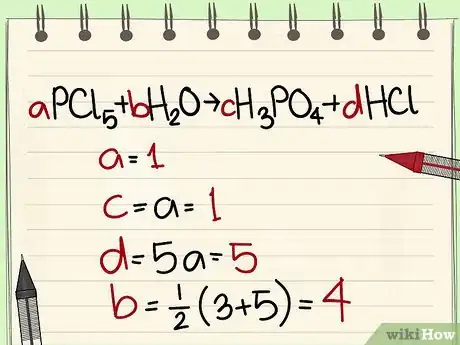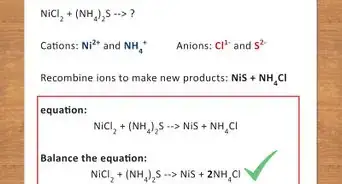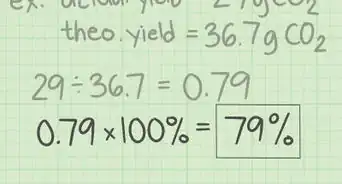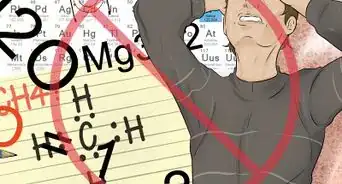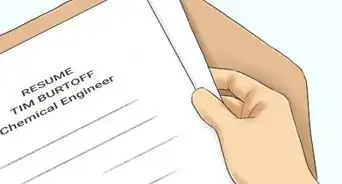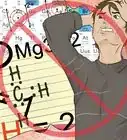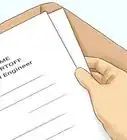This article was co-authored by Bess Ruff, MA. Bess Ruff is a Geography PhD student at Florida State University. She received her MA in Environmental Science and Management from the University of California, Santa Barbara in 2016. She has conducted survey work for marine spatial planning projects in the Caribbean and provided research support as a graduate fellow for the Sustainable Fisheries Group.
There are 7 references cited in this article, which can be found at the bottom of the page.
This article has been viewed 4,653,858 times.
Taking a dive into the world of chemical equations? These problems can seem tricky at a glance, but they’re easy to figure out once you learn the basic steps and rules to balancing them. Not to worry; we’ll walk you through exactly how to figure out just about any problem, no matter how many atoms and molecules you're working with. Dealing with especially complex equations? We’ve got you covered there, too—scroll to section 2 for a handy tutorial on solving trickier equations with an algebraic balance.
Steps
Doing a Traditional Balance
-
1Write down your given equation. For this example, you will use:
- C3H8 + O2 --> H2O + CO2
- This reaction occurs when propane (C3H8) is burned in the presence of oxygen to produce water and carbon dioxide.
-
2Write down the number of atoms per element. Do this for each side of the equation. Look at the subscripts next to each atom to find the number of atoms in the equation. When writing it out, it's a good idea to connect it back to the original equation, noting how each element appears.[1]
- For example, you have 3 oxygen atoms on the right side, but that total results from addition.
- Left side: 3 carbon (C3), 8 hydrogen (H8) and 2 oxygen (O2).
- Right side: 1 carbon (C), 2 hydrogen (H2) and 3 oxygen (O + O2).
Advertisement -
3Save hydrogen and oxygen for last, as they are often on both sides. Hydrogen and oxygen are both common in molecules, so it's likely that you'll have them on both sides of your equation. It's best to balance them last.[2]
- You'll need to recount your atoms before balancing the hydrogen and oxygen, as you'll likely need to use coefficients to balance the other atoms in the equation.
-
4Start with single elements. If you have more than one element left to balance, select the element that appears in only a single molecule of reactants and in only a single molecule of products. This means that you will need to balance the carbon atoms first.[3]
-
5Use a coefficient to balance the single carbon atom. Add a coefficient to the single carbon atom on the right of the equation to balance it with the 3 carbon atoms on the left of the equation.[4]
- C3H8 + O2 --> H2O + 3CO2
- The coefficient 3 in front of carbon on the right side indicates 3 carbon atoms just as the subscript 3 on the left side indicates 3 carbon atoms.
- In a chemical equation, you can change coefficients, but you must never alter the subscripts.
-
6Balance the hydrogen atoms next. Since you have balanced all atoms besides the hydrogen and oxygen, you can address the hydrogen atoms. You have 8 on the left side. So you'll need 8 on the right side. Use a coefficient to achieve this.[5]
- C3H8 + O2 --> 4H2O + 3CO2
- On the right side, you now added a 4 as the coefficient because the subscript showed that you already had 2 hydrogen atoms.
- When you multiply the coefficient 4 times by the subscript 2, you end up with 8.
-
7Balance the oxygen atoms. Remember to account for the coefficients that you've used to balance out the other atoms. Because you've added coefficients to the molecules on the right side of the equation, the number of oxygen atoms has changed. You now have 4 oxygen atoms in the water molecules and 6 oxygen atoms in the carbon dioxide molecules. That makes a total of 10 oxygen atoms.[6]
- Add a coefficient of 5 to the oxygen molecule on the left side of the equation. You now have 10 oxygen atoms on each side.
- C3H8 + 5O2 --> 4H2O + 3CO2.
- The carbon, hydrogen, and oxygen atoms are balanced. Your equation is complete.
- The other 6 atoms of oxygen come from 3CO2.(3x2=6 atoms of oxygen+ the other 4=10)
Completing an Algebraic Balance
This method, also known as Bottomley's method, is especially useful for more complex reactions, although it does take a bit longer.
-
1Write down the given equation. For this example, we will use:
- PCl5 + H2O --> H3PO4 + HCl
-
2Assign a letter to each substance.
- aPCl5 + bH2O --> cH3PO4 + dHCl
-
3Check the number of each element found on both sides, and set those equal to each other.[7]
- aPCl5 + bH2O --> cH3PO4 + dHCl
- On the left side, there are 2b atoms of hydrogen (2 for every molecule of H2O), while on the right side, there are 3c+d atoms of hydrogen (3 for every molecule of H3PO4 and 1 for every molecule of HCl). Since the number of atoms of hydrogen has to be equal on both sides, 2b must be equal to 3c+d.
- Do this for each element.
- P: a=c
- Cl: 5a=d
- H: 2b=3c+d
-
4Solve this system of equations to get the numeric value for all the coefficients. Since there are more variables than equations, there are multiple solutions. You must find the one where every variable is in its smallest, non-fractional form.
- To quickly do this, take one variable and assign a value to it. Let's make a = 1. Then start solving the system of equations to get the following values:
- Since P: a = c, we know that c = 1.
- Since Cl: 5a = d, we know that d = 5
- Since H: 2b = 3c + d, we can calculate b like this:
- 2b = 3(1) + 5
- 2b = 3 + 5
- 2b = 8
- b=4
- This shows us the values are as follows:
- a = 1
- b = 4
- c = 1
- d = 5
- If the value you assigned returns fractional values, just multiply all values by the least common multiple (LCM) of the denominators to get rid of the fractions. If there is only one fraction, multiply all values by that values denominator.
- If the value you assigned returns coefficients that have a greatest common factor (GCF), simplify the chemical equation by dividing each value by the GCF.
Community Q&A
-
QuestionHow did the oxygen became 7 when 3x2 is 6? Do you always add one?
 Community AnswerYou get 3x2=6 oxygen atoms in the carbon dioxide, but at this stage there is also 1 oxygen atom in the water. So, 6+1=7.
Community AnswerYou get 3x2=6 oxygen atoms in the carbon dioxide, but at this stage there is also 1 oxygen atom in the water. So, 6+1=7. -
QuestionHow can I balance NaCl + AgNo3 -> AgCl + NaNO3?
 Community AnswerThis equation is already balanced when using the first method (Traditional balance) in the article.
Community AnswerThis equation is already balanced when using the first method (Traditional balance) in the article. -
QuestionWhat causes the color of copper sulphate to change when an iron nail is dipped into it?
 Community AnswerWhen iron (Fe) and copper sulphate (CuSO4) solution react, they undergo a single displacement reaction, also known as a substitution reaction, to form solid copper (Cu) and aqueous iron sulphate (FeSO4). The iron can be solid or aqueous but the copper sulphate must be aqueous in order to facilitate the reaction.
Community AnswerWhen iron (Fe) and copper sulphate (CuSO4) solution react, they undergo a single displacement reaction, also known as a substitution reaction, to form solid copper (Cu) and aqueous iron sulphate (FeSO4). The iron can be solid or aqueous but the copper sulphate must be aqueous in order to facilitate the reaction.
Warnings
- During the balancing process, you may use fractions to assist you, but the equation is not balanced as long as there are still coefficients using fractions. You never make half of a molecule or half of an atom in a chemical reaction.⧼thumbs_response⧽
References
- ↑ https://sciencing.com/number-atoms-element-5907807.html
- ↑ http://www.sky-web.net/science/balancing_chemical_equations.htm
- ↑ https://opentextbc.ca/introductorychemistry/chapter/the-chemical-equation-2/
- ↑ https://opentextbc.ca/chemistry/chapter/4-1-writing-and-balancing-chemical-equations/
- ↑ http://chemed.chem.purdue.edu/genchem/topicreview/bp/ch3/equations.html
- ↑ https://www.bbc.com/bitesize/guides/zs3297h/revision/1
- ↑ http://www.chembuddy.com/?left=balancing-stoichiometry&right=algebraic-method
About This Article
To balance a chemical equation, first write out your given formula with the reactants on the left of the arrow and the products on the right. For example, your equation should look something like "H2 + O2 → H2O." Count the number of atoms in each element on each side of the equation and list them under that side. For the equation H2 + O2 → H2O, there are 2 hydrogen atoms being added to 2 oxygen atoms on the left, so you would write "H=2" and "O=2" under the left side. There are 2 hydrogen atoms and 1 oxygen atom on the right, so you would write "H=2" and "O=1" under the right side. Since the number of atoms in each element isn't identical on both sides, the equation is not balanced. To balance the equation, you'll need to add coefficients to change the number of atoms on one side to match the other. For the equation H2 + O2 → H2O, you would add the coefficient 2 before H2O on the right side so that there are 2 oxygen atoms on each side of the equation, like H2 + O2 → 2H2O. However, subscripts can't be changed and are always multiplied by the coefficient, which means there are now 4 hydrogen atoms on the right side of the equation and only 2 hydrogen atoms on the left side. To balance this, add the coefficient 2 before H2 on the left side of the equation so there are 4 hydrogen atoms on each side, like 2H2 + O2 → 2H2O. Now the number of atoms in each element is the same on both sides of the equation, so the equation is balanced. Remember that if there's no coefficient in front of an element, it's assumed that the coefficient is 1. To learn how to balance chemical equations algebraically, scroll down!
